February 28, 2020
Disfigured, by Amanda Leduc
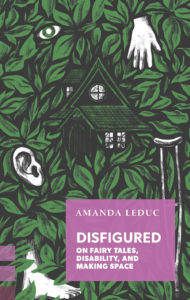
While I was intrigued by the premise of Amanda Leduc’s Disfigured: On Fairy Tales, Disability, and Making Space, I wasn’t anticipating just how interesting I would find the book, as someone who can get through the day (for now, at least) without giving disability a whole lot of thought and who also didn’t grow up with a strong connection to fairy tales, Disneyfied or otherwise. A few years older than Leduc, I was lucky enough to make it out of childhood without ever longing to be Ariel and before the age when Disney started marketing dresses, so that if I’d ever wanted to dress up as a princess, I would have had to design the costume myself— and that is only part of the reason I never did.
But to say that I did not grow up in a culture steeped in the messages and symbolism of fairy tales, steeped in those stories, would be disingenuous, as Leduc makes clear in Disfigured. Because these stories are everywhere, and yes, they’re only stories… but they’re not only stories. And throughout those stories are representations of disability—hands and heads chopped off in Grimms’ tales that magically grow back, and dwarfs, and women without voices, and witches with crutches, hideously disfigured beasts, and changelings, plus fairy godmothers who exist to reverse one’s fortune.
Leduc, who has cerebral palsy, uses her own experiences (and the text includes her own childhood medical records) to tell a story of what it means when happily ever after means learning to live with one’s disability, instead of magically overcoming it—and suggests that what must be overcome is society’s ableism instead. Disfigured is gorgeously written, a fascinating blend of memoir, scholarship and cultural commentary, a quick read that’s also packed with stories about fairy tales and disability, as well as questions and curiosities. It’s the kind of book that illuminates the ordinary and points to possibilities for a better kind of world.
February 6, 2020
Don’t Look Down, by Hilary Davidson
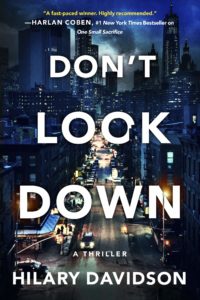
Oh, give me a great novel in February, a book to get lost in, a book that has me spending the whole day anticipating the point when I can get back to it and find out what’s going to happen next, because I’ve got absolutely no idea. New York-based Canadian crime writer Hilary Davidson’s latest novel, Don’t Look Down, was that book for me this week, such an absolute pleasure.
It begins with Jo Greaver, the young CEO of a successful cosmetics company, who’s on her way to a dilapidated apartment building for a meeting with whomever has been blackmailing her with photos and videos from her troubled past. She’s got a bagful of cash and she’s also got a gun, and then the encounter turns violent, she’s got no choice but to use it, escaping down the fire escape to save her life.
When NYPD Detective Sheryn Sterling arrives on the case, it all looks pretty simple. There’s a dead guy and he’s got Jo Greaver’s card in his pocket. When Greaver finally surrenders to authorities, all the pieces seem to line up, and she’s going to be charged with the murder of Andray Baxter, the man whose body was found in the apartment. But of course, nothing is simple and Sheryn Sterling knows that. She’s also still thinking about her teenage son who had the day before been arrested at a protest against the deportation of illegal immigrants. The thirst for her justice that drives her, Sheryn knows, could get her son into all kinds of trouble, and as a Black policewoman and as the mother of a Black boy, the stakes for her are very complicated.
Don’t Look Down is the kind of book you can point to when people cry CENSORSHIP at scrutiny of how stories about characters who are Black or people of colour are being told (and by whom). Because the fact is not that a white author can’t do it, but instead that she has to do it so well, and I think that Davidson really does in this novel, which engages smartly and thoughtfully with race and racism. White is not the default for Davidson’s characters, which a reader would expect from any halfway decent novel set in New York City—Sterling’s partner is Latinx, a key witness is Thai, Jo Greaver’s vice-president is Chinese-American, her lawyer has a Japanese surname. (This is just a handful of examples.) These choices are thoughtful and interesting, and a reflection of the world as it is.
The story is twisty and absorbing, and I had no idea how it was all going to turn out. Deftly plotted, it did not even begin to get a little bit silly and over-the-top until close to the end, which is altogether forgivable. The writing was great, dialogue fun and snappy, and the pacing never missed a beat. Don’t Look Down was delightful, and everything I want in a read.
December 9, 2019
Girl, Woman, Other, by Bernardine Evaristo
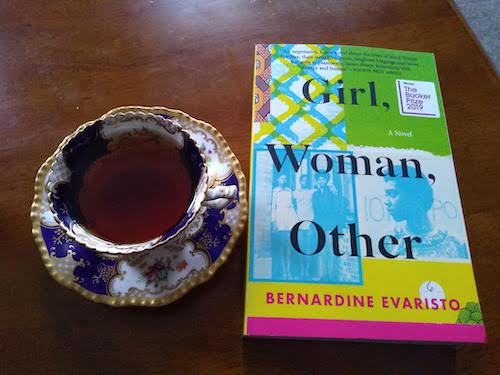
It’s so good. It’s that simple. Girl, Woman, Other is the first book by Black woman to ever win the Booker Prize (a long time coming, right?) and so you should read it, but you’ll also want to . You will start reading and not want to put this book down, and in the meantime you’ll be raving about it to strangers on the streetcar. That is, if your experience is anything like mine.
Evaristo has explained the style of the novel as “fusion fiction”: “that’s what it felt like, with the absence of full stops, the long sentences. The form is very free-flowing and it allowed me to be inside the characters’ heads and go all over the place – the past, the present.” Ostensibly about a single evening in London as a play by a Black lesbian playwright opens at the National Theatre, the novel spans the twentieth century, moves between communities in Britain, Africa and the Americas, and tells the story of twelve central characters from birth to death in a few cases, and in others to the present day. It’s a novel “about Black womanhood,” but what falls under that umbrella is wide-ranging, kaleidoscopic, diverse and disagreeing in the most fascinating way. This is a novel that’s rich with twists and connections, and surprises.
The characters include Amma, the aforementioned playwright, who recalls her radical days in contrast to now being considered establishment (or as much as a Black woman could ever be); her daughter who must find new ways to rebel against her counterculture parents; and her longtime friend and former collaborative partner, who fell in love and moved to a feminist commune in America where she becomes trapped in an abusive relationship.
The connections are not always clear at first—Carole, a superstar in the world of finance, is attending Amma’s play, but she’s part of the tapestry in other ways as well, and so is her mother, Bummi, who steers the following section, telling the story from her youth in Nigeria, her immigration to England, the death of her husband, and her determination to build a business and succeed—as well as her disappointment at how her own daughter’s success has put distance between them. And then we meet LaTisha, once upon a time Carole’s classmate, but her life took on a different kind of trajectory.
Amma’s childhood friend, Shirley, who teaches unruly youths at a London school, who started out teaching with big dreams and great ideals, which become ground into nothing after working through the Thatcherification and bureaucratization of teaching and society in general in the 1980s. And Shirley’s mother, Winsome, whose own story comes with a surprising twist, and Penelope, Shirley’s colleague, who’s got one of her own.
And then a non-binary social media influencer, Morgan, and their great-grandmother, Hattie, who lives on the family farm near Newcastle, and her own mother, Grace, which takes us to long before and far away from the opening night of Amma’s play, but everything is connected, in satisfying and illuminating ways.
That a single novel can hold so much is extraordinary —and that it can do it while being stylistically innovative and so joyful to behold is even more so. Girl, Woman, Other is magnificent, and honestly, it’s the only Booker winner you need.
December 3, 2019
Ducks, Newburyport, by Lucy Ellmann
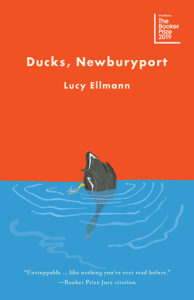
“Well, there’s a book I’m never going to read,” was my first thought upon hearing about Ducks, Newburyport, by Lucy Ellmann, the 1000 page book consisting of (mainly) a single sentence, shortlisted for the Man Booker and winner of the Goldsmiths’s Prize. Because you know how there are people who carry about tote-bags that say, “I like big books and I cannot lie?” I am not one of those people. I don’t like big books, not at all, not because of the heft necessarily (check out my own tote-bag, where I’m often carrying no less than three hardcovers at a time. I can lug book weight), but because for me so much of the pleasure of reading is thinking about what I’m going to be reading next, and the same book for weeks at a time slows me down, makes me feel like I’m standing still. Long books don’t fit easily into the pattern of my life. It’s also a huge demand to make of a reader as well, 1000 whole pages, and I’m usually irritated by anybody who’d dare to ask it.
You can keep Your Struggle, buddy. I’ve got enough of my own.
The shift began from Twitter commentary, however . (Yes, it turns out Twitter has a purpose after all.) Steven Beattie tweeted that it read up quick, and by the time Biblioasis Publisher Dan Wells had sent me an email promising that this would be a novel right up my street, I’d already started reading it.
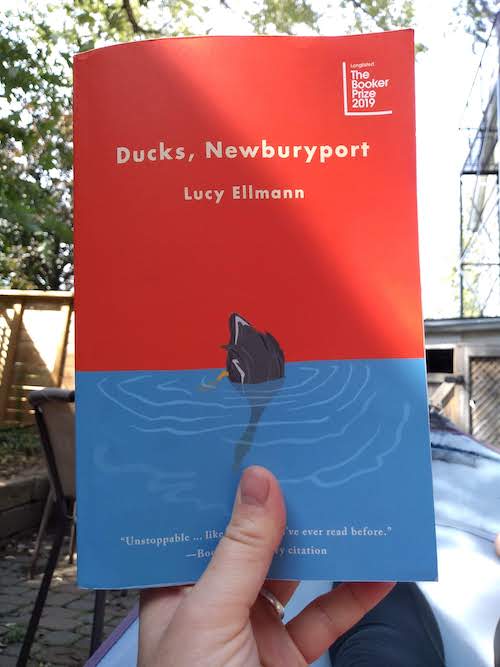
With Ducks, Newburyport, I did what I always do with huge and overwhelming challenges, which is that I broke it down into manageable pieces. Though I have heard others making a solid commitment to the novel, going in for the long haul, and they report enormous pay-offs, because it’s an amazing novel, and what a thing to give it one’s entire focus. But that’s not the reality of my reading life right now, where focus gets spread thin, and there are so many other books I have to read in the meantime, so instead of going all in for Ducks, I committed to reading 5 or 10 pages every night, and I liked that it was the kind of book that was easy to dive in and out of again. If I’m going to read 1000 pages, this is way I would like it to happen. It’s give and take.
And so it took me three months to read it, as opposed to binge-reading, and this has had a curious effect on my life. As though Ducks, Newburyport was like a plant with amorphous tendrils, and as I read, they crept their way into every facet of my life, until I was no longer sure where I ended, and Ducks, Newburyport began.
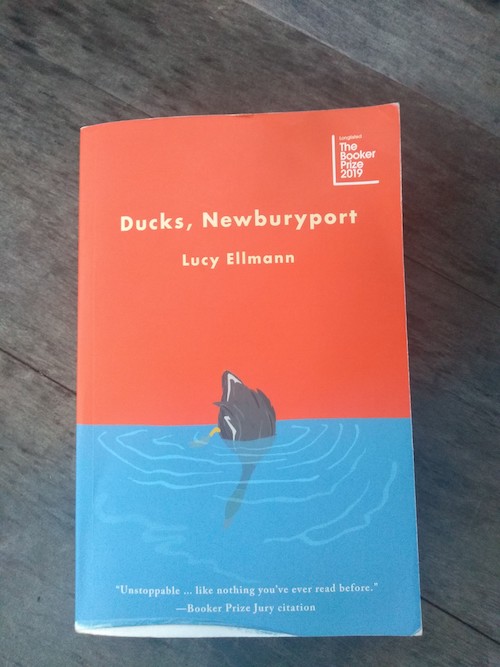
“That’s a lot like Ducks, Newburyport,” began to be the thing I said at parties, or on Twitter, no matter the topic, really, because everything is a bit like Ducks, Newburyport. Or perhaps what I mean is that Ducks, Newburyport is like life itself, which is the point of the exercise. Somebody talking about how they can never remember the word for nasturtiums, and maybe the unnamed narrator of Ducks, Newburyport had been talking about hydrangeas, but such distinctions mattered as much as the distinction between fiction and life. Everything was blurry.
It’s not accurate to say that this book is a single sentence, clauses conjoined by commas and the phrase “the fact that” to form the stream of consciousness of an Ohio woman baking pies and cookies in her kitchen, because to say this would be to forget about the parts of the novel that are written from the perspective of a cougar. Or a mountain lion, “the lioness.” What kind of novel is this anyway?
It’s the kind of novel that’s concerned with ordinary things, the mundane, the domestic. Except what does it mean that among these things ordinary and domestic are mass shootings and domestic homicides, a lunatic president and the rise of ethno-nationalism? These things melding in with the other, as our unnamed narrator caramelizes apples for tartes tatin, and fails to avoid painfully stepping on her son’s plastic toys, and worries about her distant teenage daughter, and thinks about the amazing fact of her love for her husband, never mind the sorry state of her libido, especially since her recovery from cancer not so long ago, rotting window frames and the guilt she feels for her failure to be a proper parent to her four children at the time, and she’s still not over the death of her own mother, and how their whole family fell apart during the years her mother was ill, and now her husband works so hard, is often travelling, and she adds to their income with her home baking business, because they’re broke after all her healthcare bills, supplying local shops and restaurants, her labour too blurs boundaries, both paid and domestic. And undervalued all of it.
Oh oh my gosh, the popular culture, classic films, and Meryl Streep and Dustin Hoffman (and how he was mean to her during Kramer Vs Kramer, when she’s a better actor than she’ll ever be), and the passages about Julie & Julia (“only we hate the Julie bits…”) and so much ruminating about Little House on the Prairie (as you do…), and bridge building (her husband, Leo, is an engineer), and musical theatre, and Harrison Ford and Witness, and the bee at Bread Loaf. Always, the bee at Bread Loaf, and we never actually learn anything about the fact of the bee at Bread Loaf, but other parts of the story we begin to be able to put together, puzzling out, like who is Abby, and her first marriage to Frank, and what happened to her mother, and the fact of the ducks at all. And Newburyport.
And oh, the angst of baking, her worries about sending these goods out into the world never sure that they’ve turned out successfully, because the proof is in the eating, and you can’t control it all. She’s got a freezer packed with failed experiments in lemon drizzle cake, not bad enough to be abject disasters, but not good enough to sell, and she feels guilty subjecting her children to it. Children are never enthusiastic about lemon drizzle cake anyway, the lack of frosting. Who’s actually enthusiastic about lemon drizzle cake anyway? Lemon drizzle cake existential angst, I mean. I’ve never felt so seen before. The kind of stuff that keeps me up at night.
There’s a chicken coop, and pets, and time passes, weeks and months, and in the breaks, the lioness wanders with her cubs, on overpasses and through thickets, across backyards and down into ravines, and she would like to keep her distance from humans, but she cant help it, and she becomes separated from the cubs, who are taken away in a truck to the Columbus Zoo.
Ohio is a funny place, not so different from the stories about the Florida men, really. Insane abortion laws and women kept captive in basements, and fact and fiction blurs too as our narrator recounts the stories she’s heard, news headlines. Some of them true, but it starts to feel like all of them are factual, because everything else in the novel is so familiar after all, that it becomes uncanny how much of it is not uncanny, when possibly it should be. What does it say about the world we live in (and all of us, in general) if it isn’t?
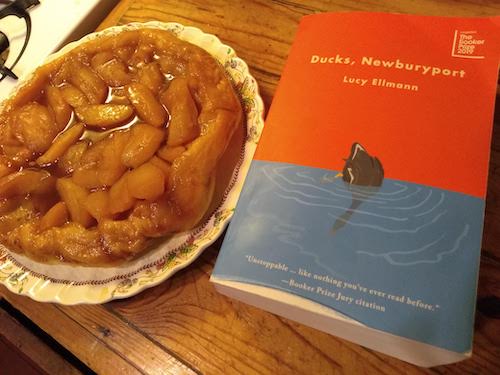
Against this backdrop of her stream-of-consciousness, a lot actually happens, although you could almost miss it, because the tone of the narrative never changes whether she’s concerned about puff pastry or is actually imperilled. She gets stranded in a snowstorm while out delivering pies, and takes her family to a mall whose parking lots entrance is washed away in a flash flood (which is the kind of thing that happens now, in Ohio and elsewhere), and then her daughter goes missing, seemingly every mother’s worst nightmare, save for another one which she comes face-to-face with by the novel’s end. But no spoilers…
Is there such thing as a pre-apocalyptic novel, was a thing I wondered as I read this book, an ordinary story with such ominousness at its margins, and creeping ever-closer, which is pretty close to how it feels sometimes to live in the world right now.
It was a commitment, this book, even if the smaller pieces I broke it into, and the other night as I finished it, I could not quite fathom what it would be like to not have this book sitting on my bedside. Three months is a long time, a quarter of a year, and as I read this novel, weeks went by, the season changed, we celebrated holidays and birthdays, had a federal election, I baked tens of dozens of muffins, and now the book itself feels indelibly connected with all of it.
This novel’s outsizedness, its audacity, is a statement on the curious proportions of life itself. What gets to be an epic? The fact that (as she’d put it) I might have spent more time ruminating on a disappointing drizzle cake than yesterday’s mass shooting; climate change and (not or) a teenage daughter’s petulance; saving the world and raising one’s children; a single person against the enormity of the human population—it’s all enough to make you go cross-eyed, to be honest. How do you understand it all, attempt to contain it all?
With this novel, however, Ellmann gets come close. A book that seems like a feat of endurance, at first, but turns out to be so much more than that.
November 28, 2019
Five Wives, by Joan Thomas
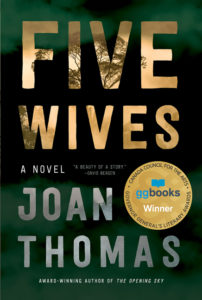
There’s a possibility I might have let the year pass me by without picking up Joan Thomas’s latest, Five Wives, winner of the 2019 Governor General’s Award for Fiction. And what a disaster that would have been, my reading year without one of the best books of the year included. But disaster was averted because I finally picked up the novel last week, and it was one of those experiences like I mentioned while I was writing about The Dutch House. As in, I was instantly enveloped and not remotley moved to clean my bathroom . (Full disclosure: this novel was actually one of those books I read in the bath until the water got so cold…)
Based on the true story of a group of American evangelical missionaries murdered in the Ecuador jungle in 1956 after making contact with an isolated Indigenous group, Thomas blurs fact and fiction fascinatingly in Five Wives—as she did with her earlier novel, Curiosity, which imaged the life of nineteenth century fossil hunter Mary Anne Anning. Billed as “in the tradition of The Poisonwood Bible,” I actually found the novel more in conversation with Miriam Toews’ Women Talking (with shades of Irma Voth!) in its consideration of the role of women in religious communities, in religion in general, and also with the fraught question of female solidarity. Because as with the women of Women Talking, and women anywhere, actually, and with people in general, the women of Five Wives do not speak with a single voice and view their shared story through very different lenses.
Although when the novel begins, theirs is a collective voice, “the wives,” in the immediate aftermath of the deaths of their husbands. The narrator does not distinguish these women, who themselves are “putting the story together”of what had befallen the men. A story that would become legend in evangelical circles, a story Thomas herself grew up hearing told, as she explains in her interview at 49thShelf. But in her novel, she complicates this mythology and explores the way in which story and narrative is constructed from the raw material of facts.
The novel’s present day story line concerns a young woman called Abby, whose mother and father had each lost their own fathers in the massacre, and had grown up steeped in the story, as her father, David, a pastor, also had. This part of the novel begins at the funeral of Abby’s maternal grandmother, Elizabeth Elliot (a real life figure whose own writings have been instrumental in spreading the story of what happened in the Ecuadorian jungle, and how the Waorani people eventually did convert to Christianity, thereby ensuring that this story of martyrdom ended in triumph and glory). And now Abby has lost her faith, much to the chagrin of her father, and we see the tension between them as she tries to find her own way, which challenges David’s own faith, in many things, including the truth of what he knows about what happened to his father and the story his family continues to tell about it to the world.
More central to the plot are the stories of the wives themselves, however, and their own struggles and challenges, those things they are sure of and that which they doubt. Abby’s grandmother, Betty, for whom missionary work was a vocation, and then Olive, who has followed her husband to Ecuador (and we meet her in the years before her marriage, when she’s attending university and developing independence from her religious family), and Marj, David’s mother, who ran the guesthouse where so many of the missionaries stayed, and her relationship with her sister-in-law, Rachel, the one woman in the group who is nobody’s wife. (“Goodness is more complicated that Marj ever imagined.”
And then Cornell Capa, the photographer from Life Magazine, who took the photographs that showed what happened in the jungle to the world—also a real-life character to whom Thomas grants a fictional inner life. And in the contemporary timeline, a film is being made about the massacre, and so there are lots of opportunities for Thomas to play with and complicate the idea of truth and myth and how stories get told.
The novel is a puzzle, pieces fitting together in surprising ways. The women’s own stories are not told chronologically, and overlap in some aspects and there are gaps in others, and not all the women are as central to the story. There is cultural appeal in this novel about mid-20th century womanhood and wifehood, which Thomas complicates interestingly, in addition to the layer of faith, religion and colonialism which complicates everything even more.
November 5, 2019
The Dutch House

I knew I was in trouble the night I was reading in the tub, and then called for my husband to bring in a box of baking soda and a cloth so I could scrub the grout between the wall tiles. My grout is dodgy at the best of times, but it really does take a special level of “not into a book” to drive me to clean my bathroom instead. Which was not the case with Ann Patchett’s latest novel The Dutch House, which I finished reading last night in a two hour whirlwind. Patchett’s books are a bit hit-and-miss with me—truth be told, I didn’t love Commonwealth. I liked it. It didn’t drive me to scrub the tiles, I mean, but it didn’t live up to my high expectations. Oh, but The Dutch House swept me away, and the twists and turns were never what I’d expected them to be. I have no idea how you’d dream up a narrative like this, the form and shape of it, I mean. I’ve been thinking about the specificity of the narrative of Ian Williams’ Reproduction, and this book is similar, the curious shape of family and of life and how few books actually manage to properly express that.
October 24, 2019
Empire of Wild, by Cherie Dimaline
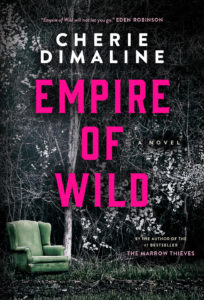
How does an author follow up a success like The Marrow Thieves, Cherie Dimaline’s bestselling novel that won so many awards and prizes that they ran out of room on the cover? The most straightforward answer I can think of was also Dimaline’s herself, which was to publish Empire of Wild, a book that’s unabashedly excellent, gripping, funny, gorgeous, and dark. I read this book when I was taking part of in a read-a-thon last weekend. No, not that one that is my life, but the other one, raising money for metastatic breast cancer research. And Empire of Wild was the perfect novel for this experience—I couldn’t put it down, even if I’d wanted to.
It’s a book that reminded me a bit of Bad Ideas, another one of my favourite novels this year, about impossible love and what it means to believe in it. Empire of Wild begins with Joan, whose husband Victor has been missing for almost a year. He’d left the house after an argument they’d had about selling her family’s land. Hasn’t been seen since, though Joan’s not given up hope of his return just yet. And then one early morning, nursing a hangover, Joan walks into a revival tent in a Wal-Mart parking lot and discovers a man she knows is Victor, but he’s also a preacher whose name is Eugene Wolff. So who is he anyway? And what’s up with these holy rollers who seem to turn up in Indigenous communities who are making deals with big mining companies? Add to the mix a Rogarou, a werewolf-like creature from Metis stories, and you’ve got a plot-driven thriller on your hands.
Will Joan succeed in finding her husband again? Is Victor even still alive? With her Johnny Cash-obsessed nephew riding shotgun, Joan sets out to discover the answer to these questions, risking her own life in the process, and the result is an absolute terrific read, as powerful as it’s propulsive, plus the humour even in the darkness, savvy and self-aware lines like, “Sure hope those jackasses haven’t built over the spot. If they have, I hope those scary movies having it right and building over old Indian stuff makes your kids disappear into televisions.”
October 17, 2019
Daughters of Silence, by Rebecca Fisseha
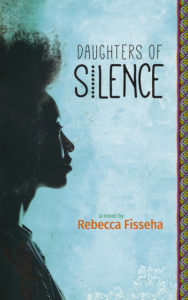
Rebecca Fisseha’s novel Daughters of Silence is dazzling, partly because it’s particularly well crafted, but also in the sense that it messes up your vision a bit, that you’re not quite sure what you’re seeing at first. Because the book is a puzzle, a mystery unfolding, and also a circle. I’m so grateful that I had the chance to read it twice, because it’s one of those marvels, a novel that get better and richer with every encounter.
The first time I read it was in the spring in manuscript form after I’d received a message from its editor, who was once my editor, Bethany Gibson, asking if I’d consider blurbing the book. And Gibson’s passion for the novel as so apparent in her message that I agreed without hesitation. I read the novel, and I liked it, the ending in particular. I wrote, “Featuring gorgeous prose and a most compellingly prickly narrator, Fisseha’s debut novel is a puzzle, a page-turner, and a triumph.”
But then I reread the book two weeks ago in anticipation of my conversation with Fisseha at her book launch last weekend, and I wanted to go back to my blurb if only to underline it emphatically at least a million times.
Fisseha comes at her story with a singular, distinctive style, and a character who’s not here to make friends. No, instead Dessie is working to uncover the truth in her own history, the history of her family, truths she’s spent decades unable to face, hiding abuse and trauma in which the people who loved her were partly complicit, and the reader is simply along for the journey, following Dessie as she makes impulsive leaps and takes her own road. Unable to hide from her past anymore, because she’s stuck back in Addis Ababa, her birthplace, after her plane is one of thousands grounded all over the world after the eruption of an Icelandic volcano. Disturbances in the atmosphere, you know, but where the planes can’t fly, Dessie herself manages to discover some clarity, some answers, especially about the experiences of her mother who has recently died and has been buried in Toronto, not back in Ethiopia as had been what was expected.
In her essay for LitHub “on #MeToo in Ethiopia and Eritrea,” Fisseha writes powerfully about what happens when women decide to tell the truth about their own lives: “Perhaps because of my own predisposition to doom and gloom, I had interpreted Rukeyser’s line the world would split open as a disaster scenario. But now I realize how flexible that line is….The world could split open like a flower in bloom, like a woman shattering the glass that had separated her from true connection. Like the global event that became multitudes of habesha women finally telling their stories online…”
The real-life connections to Daughters of Silence do serve to underline the power of story in general, and in this story in particular, but let them not undermine the fact of what a fabulous work of fiction this novel is. The style, remember? The dazzle. Let Rebecca Fisseha take you on a journey. You will be glad you did.
October 8, 2019
Watching You Without Me, by Lynn Coady
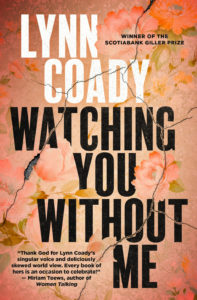
I’ve been a big fan of Lynn Coady for awhile now, since I read Mean Boy back in 2006. I absolutely adored her most recent novel, 2011’s The Antagonist, and I really enjoyed puzzling my way through her Giller Award-winning Hellgoing a couple of years later. Hellgoing, a book that, like the trajectory of Coady’s writing career, is packed with twists and turns, a resistance to the boring, conventional or expected. A resistance that continues right up her latest, Watching You Without Me, a thrilling and engrossing ride of a novel, a most unsettling but utterly captivating read.
Her protagonist is Karen, who returns home to Halifax after the death of mother to take care of things, and to sort out the future of her older sister, Kelli, who is developmentally disabled. The moment both Karen and her mother had been resisting for years, especially after an epic battle they’d had decades before when Karen voiced her refusal to be responsible for Kelli’s care and also blamed her mother for having her identity subsumed into that very thing. But the reality of the situation is more complicated than that, as Karen begins to realize as she becomes reacquainted with her sister and the household, whose demands are made somewhat easier with the curious presence of Trevor, her sister’s care-worker, who, it turned out, had come to play an important role in the family’s life while Karen was away.
But Trevor’s presence is also an uneasy and unsettling one. His familiarity makes Karen uncomfortable, she doesn’t really like him, he has “issues,” as they say, control issues in particular, and a propensity for flying off the handle. But Karen is also desperate, and vulnerable in the wake of her mother’s death, and she allows Trevor to continue to make a place for himself in the household, because he’s kind of a master manipulator, but also she needs all the help she can get.
Karen is a fascinating, solitary figure whose more recent history is glossed over, save her a recent divorce, but her lack of friends and confidantes is conspicuous. An elusive narrator, she sees what she wants to see, and does an effective job of shaping the narrative to her purposes, but there are moments when we see through to the story behind the story, and the story behind that, each of these worthy of novels onto themselves, so many questions—the complexity here is wonderful.
Karen’s story reminds me of the narrator of Helen Phillips’ The Need, recently nominated for a National Book Award. Another sinister book about the unrelenting demands of caregiving and how a person might crack underneath them to make some questionable choices. About how one might take whatever relief they’re offered, even if they know it’s a really bad idea, but it’s rather enticing, the opportunity for just a few moments of rest and also the assurance that somebody else, for once, is in control of the chaos.
Claire Tacon’s wonderful 2018 novel, In Search of the Perfect Singing Flamingo, also similarly explores disability and families, and the experience of being the adult sibling of a person with developmental disabilities, although the siblings’ parents are still alive in Tacon’s novel, and the idea of what happens once they’re gone just looms on the novel’s horizon. Coady’s novel, unflinchingly, takes the reader right there, that moment of the realization of so many parents’ fears for their children, but what is to be most feared actually arrives in the form of a saviour. And the unfolding story of just who Trevor is and what his intentions are results in a roller-coaster ride of a read—which is a remarkable feat when the reader considers that these are characters who barely leave the house.
September 4, 2019
Trick Mirror, by Jia Tolentino
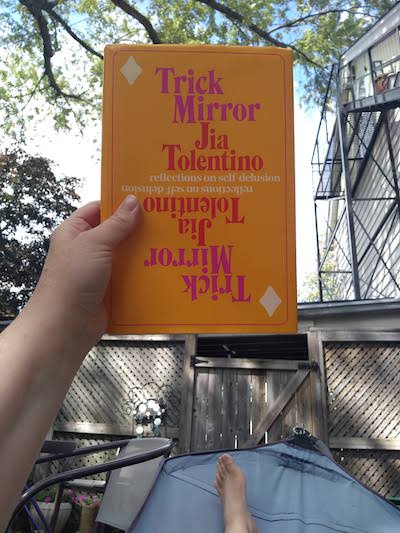
I don’t think I’ll ever be ready to write a post about Jia Tolentino’s essay collection Trick Mirror, but I was set to do some preparatory work before I did. Because these aren’t essays that I’m finished with yet, or completely understand properly. These aren’t blog posts or hot takes that have been churned into book—these are essays 40-50 pages long, and one concludes with, “I wish I had known…that the story didn’t need to be clean, and it didn’t need to be satisfying; that, in fact, it would never be clean or satisfying, and once I realized that, I would be able to see what was true.”
I am still trying to puzzle my way through her incredible “The Cult of the Difficult Women,” which explores the way that Daring Girls pop-feminism becomes weaponized for anti-feminist purposes—”But when the case for a woman’s worth is built partly on the unfairness of what’s levelled at her, things get slippery…” My OOF moment in “Pure Heroines,” about literary girlhoods and the limits of literary womanhood, rich for me with familiar points of reference, when she writes, “You’ll have noticed—surely, you’ll have noticed, though I don’t want to be too generous—that all the characters in this essay are white and straight.”
These essays are trickier than most others I’ve ever encountered, pulling away and pushing on just when you think they’re settled, and resisting tidiness, easiness. So that the reader comes away with their mind still spinning, work to be done. Tolentino offers no conclusions, resolutions. She is not going to do the work for you.
I read a review recently that focussed on the bleakness and despair in these essays, works that make connections between the Fyre Festival and the 2008 financial crisis (and GirlBosses) and a culture of scamming: “There are fewer and fewer options for a person to survive in this ecosystem in a thoroughly defensible way.”
But bleakness and despair was not my takeaway from Trick Mirror, the title a statement on the nature of true and reality, delusion and self-delusion. How do you know when what you see, or what you are, is real? And just when you think you’ve got it settled, it’s gone and changed again. And bleakness and despair was not my takeaway because it took me almost two weeks to finally buy this book, which was sold out at every bookstore I showed up at. And if the demand is so high for these rich and erudite works, essays that aren’t going to fucking let you get away with it or get away with anything… The way I feel every time I see the way that someone (usually Ali Smith) has made something so artful for these torrid time we’re living in—oddly hopeful, even. Not all yet has been lost.





